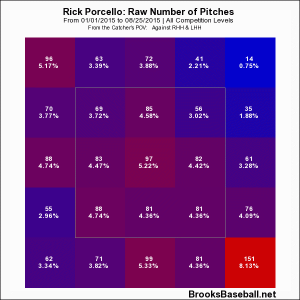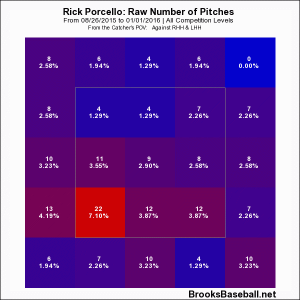Anytime a season goes as poorly as 2015 has gone for the Red Sox, there are going to be a lot of disappointments. Between Pablo Sandoval and Hanley Ramirez, much of the blame for 2015 has gone toward the two big offensive additions, and rightfully so. Both players have performed much more poorly than any reasonable person could’ve expected them to. With that being said, one could very well argue that Rick Porcello has been the most disappointing player on the team this season.
Even if you, like me, thought the big extension Porcello signed prior to this season was a bit too much, nobody could have expected him to be this bad. The argument was never about whether or not he was a bad pitcher or not. It was always about whether a pitcher of his caliber — i.e. an average-ish pitcher — was worth that kind of money. The fact that he was an average-ish pitcher was something of a foregone conclusion.
Those expectations flew out the window somewhat early, as the 26-year-old got off to a rocky start and could never really recover. Overall, he’s thrown 137 big-league innings this season and boasts a 5.12 ERA, a 4.48 FIP, a 4.75 DRA and a 101 cFIP while allowing a .273 TAv. Among the 122 pitchers with at least 100 innings, he ranks 113th in ERA, 93rd in FIP, 95th in DRA (and DRA-) and he’s tied for 59th in cFIP. Whichever way you slice it, he’s been bad.
What’s strangest is how Porcello has been so bad. In the past, he’s relied on weak contact and ground balls — a strategy that didn’t always work due to the Tigers’ poor defense, but one that could theoretically produce great results with the right roster. For whatever reason, he stopped pitching like that in 2015, instead staying up in the zone more and relying more heavily on his four-seam fastball rather than his sinker. As a result, Porcello saw his strikeout numbers improve, but he also gave up a lot more hard contact.
However, looking at more recent data (as well as admittedly small sample sizes), he has looked much better lately. Porcello left his start on July 29 after just two innings and his ERA had ballooned up to 5.81. The Red Sox then put him on the disabled list with a triceps injury, and he wouldn’t come back for about a month. He’s made three starts since coming back to the rotation. While that’s not enough time to say he’s completely fixed and we no longer have to worry about him, it’s enough time to look at trends and try to find any substantial differences.
Overall, he’s thrown 22.1 innings in those three starts, which is a good start on its own. After throwing at least seven innings in just six of his first twenty starts, he’s done it in each of his last three, saving a bullpen that needs all the help it can get at this point. Even better, Porcello is pitching to a 1.61 ERA while allowing an opponents’ batting line of just .220/.247/.366. He is also striking out a batter per inning, though that’s largely due to a masterful 13-strikeout performance against the Yankees on September 1.
So, the overall numbers look great in this stretch, but as I said there’s too much small sample noise to be overly convinced by straight numbers. Instead, one should look at trends and approach to see if there’s anything that’s changed over the last couple of starts. I performed a similar exercise for Joe Kelly, and let’s just say the Red Sox should hope Porcello’s strides have been more tangible.
As I mentioned before, Porcello’s biggest problem early in the year was arguably the fact that he was trying to be someone that he’s not. Whether that’s because he felt he had to be different with his new contract, or he was sick of being a ground ball guy, it clearly wasn’t working. Fortunately for the Red Sox, he’s gotten back to the basics in his last three starts, trying to induce more ground balls and letting the infield behind him do most of the work. After throwing his four-seamer roughly as often as his sinker before hitting the disabled list, he’s going with his sinker much more often since coming back. In his last three starts, he’s thrown the sinker a whopping 53.55 percent of the time, leading to a substantially higher ground ball rate in that time.
It’s not just his repertoire that’s changed, either. Porcello is approaching hitters much differently in August and September. The following zone plots show a stark difference in strategy.
As you can see, Porcello has made a much more conscious effort to pound the bottom of the zone in recent starts, rather than attacking all points of the zone as he did earlier in the year. The latter strategy can work for many pitchers, but Porcello’s stuff isn’t as conducive to it, as was proven by all of the hard contact. By pounding the bottom of the zone, his strikeouts will likely fall over the long-term, but the home runs will fall with it, and he’s shown that he can be a solid mid-rotation arm with this kind of approach.
Porcello being part of the 2016 rotation is as close to a guarantee as one can get on this roster. His poor overall performance and contract combine to make him one of the hardest players to trade in all of baseball. Because of this, the Red Sox need to be encouraged by what they’ve seen so far. The front office and coaching staff needs to notice the success he’s had since changing his approach, hope it continues and convince him to pitch like that for all of next year. He may never be worth his extension, but if he continues to pitch like this, Porcello can be a contributor in a solid rotation, which is something this Red Sox team desperately needs.
Photo by Bob DeChiara/USA Today Sports Images


